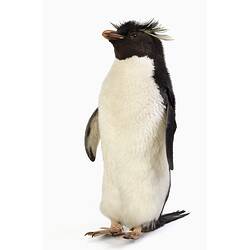General Description
Smaller penguin with black back and head and white belly. Prominent red eyes with spiky yellow and black feathers on the crown. Orange bill in adults. Weight up to 2.2 kg, head-body length up to 50 cm.
Biology
One of the most numerous penguin species, although populations have declined over the last 30 years. The species breeds on rocky coastlines and derives its common name from its behaviour of hopping among the rocks rather than sliding on their bellies like other penguins.
Distribution
Circumpolar around Southern Ocean islands; southern Chile and Argentina, Falkland Islands, South Africa - Prince Edward Island and Marion Islands, French Southern Territories - Crozet Islands, Kerguelen Islands, Australia - Heard and Macquarie Islands, New Zealand - Antipodes, Campbell, Auckland Islands
Habitat
Rocky shorelines and tussock grasses in cool temperate climates. Cold water oceans.
More Information
-
Animal Type
-
Animal SubType
-
Fast Fact
The most widely distributed penguin. Northern birds are able to breed up to two months earlier than the colder climate birds in the south.
-
Brief Id
Charasmatic penguin with red eyes, white belly, black back, wings and head, with prominent black and yellow feathers projecting from their heads.
-
Colours
Black, White, Red
-
Maximum Size
50 cm
-
Habitats
-
Diet
Carnivore
-
Diet Categories
Krill, Crustaceans, Squid
-
Endemicity
-
Conservation Statuses
CITES: Not listed, EPBC Act 1999: Not listed, FFG Threatened List: Not listed, IUCN Red List: Vulnerable
-
Taxon Name
-
Common Name
Rockhopper Penguin
-
Kingdom
-
Phylum
-
Subphylum
-
Class
-
Order
-
Family
-
Genus
-
Species Name
chrysocome
